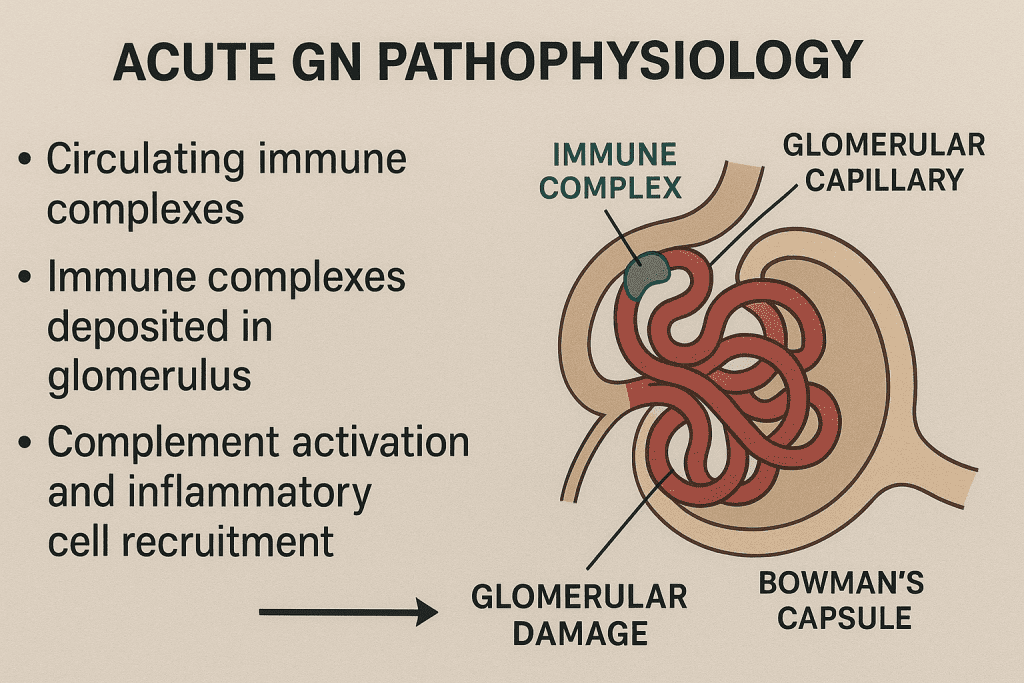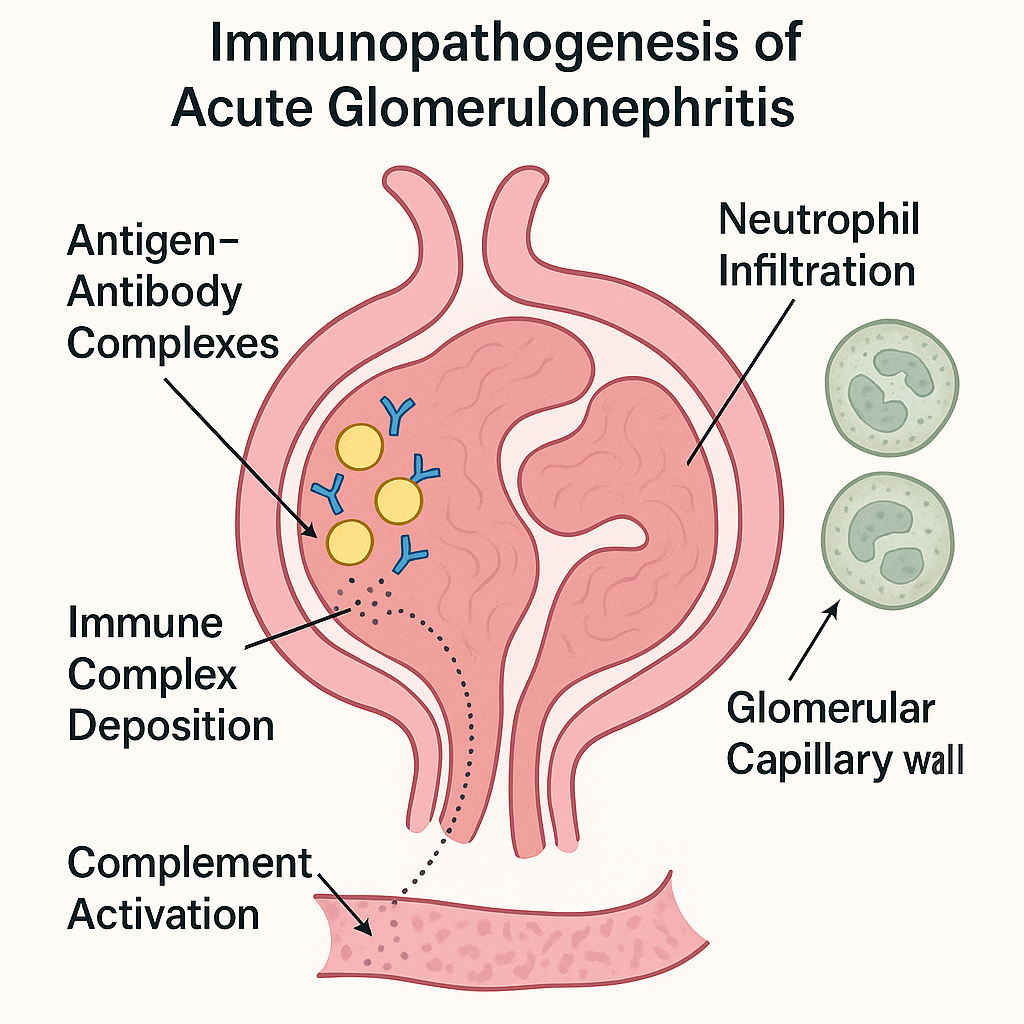📚 CONTENT
Learning Objectives
By the end of this chapter, learners will be able to:
1.Define acute glomerulonephritis (AGN) and differentiate it from other kidney diseases.
2.Understand the common causes and immunopathogenesis of AGN.
3.Recognize the clinical presentation and diagnostic features of AGN.
4.Outline the diagnostic workup, including laboratory tests and renal biopsy findings.
5.Describe the management strategies for AGN and its complications.
5.1 Introduction to Acute Glomerulonephritis
Acute glomerulonephritis (AGN) refers to a group of kidney diseases characterized by inflammation of the glomeruli, the tiny filtering units of the kidney. This inflammation leads to damage of the glomerular filtration barrier, resulting in hematuria (blood in urine), proteinuria (protein in urine), and often acute kidney injury (AKI). AGN can be primary (affecting only the kidneys) or secondary to systemic diseases.
5.2 Common Causes and Immunopathogenesis
AGN is primarily an immune-mediated disorder, where immune complexes or antibodies directly damage the glomeruli.
1. Post-streptococcal Glomerulonephritis (PSGN)
•Most common cause of AGN in children.
•Etiology: Occurs 1-3 weeks after a Group A beta-hemolytic Streptococcus (GAS) infection (pharyngitis or impetigo).
•Pathogenesis: Deposition of immune complexes (containing streptococcal antigens and host antibodies) in the glomeruli, leading to complement activation and inflammation.
•Clinical Features: Abrupt onset of hematuria (cola-colored urine), edema (periorbital, dependent), hypertension, and mild to moderate AKI.
•Diagnosis: Recent streptococcal infection (positive throat culture, rapid strep test, or elevated ASO/anti-DNase B titers), low C3 complement level, and characteristic renal biopsy findings (diffuse proliferative glomerulonephritis with subepithelial humps).
2. IgA Nephropathy (Berger’s Disease)
•Most common primary glomerulonephritis worldwide.
•Etiology: Characterized by IgA deposition in the mesangium of the glomeruli.
•Pathogenesis: Abnormal IgA1 molecules trigger an immune response, leading to immune complex formation and deposition.
•Clinical Features: Recurrent episodes of gross hematuria, often occurring within hours to days of an upper respiratory or gastrointestinal infection (synpharyngitic hematuria). Can progress to CKD.
•Diagnosis: Renal biopsy showing mesangial IgA deposition.
3. Rapidly Progressive Glomerulonephritis (RPGN)
•A severe form of AGN characterized by rapid loss of kidney function (over weeks to months) and crescent formation in the glomeruli.
•Types:
•Type I (Anti-GBM Disease/Goodpasture Syndrome): Antibodies against glomerular basement membrane. Can also affect lungs (pulmonary hemorrhage).
•Type II (Immune Complex-Mediated): Associated with systemic lupus erythematosus (SLE), PSGN, or cryoglobulinemia.
•Type III (Pauci-Immune): Associated with ANCA-associated vasculitides (e.g., Granulomatosis with Polyangiitis, Microscopic Polyangiitis). Few or no immune deposits on biopsy.
•Clinical Features: Rapidly progressive AKI, often with systemic symptoms (fever, malaise, arthralgia).
•Diagnosis: Serological tests (anti-GBM antibodies, ANCA, ANA, cryoglobulins) and renal biopsy showing extensive crescent formation.
5.3 Clinical Presentation
AGN typically presents with a combination of the following features, often referred to as the Nephritic Syndrome:
•Hematuria: Gross (cola-colored or smoky urine) or microscopic.
•Proteinuria: Usually non-nephrotic range (<3.5 g/day), but can be higher.
•Edema: Periorbital edema (especially in children), dependent edema.
•Hypertension: Due to fluid retention and activation of RAAS.
•Acute Kidney Injury (AKI): Elevated serum creatinine and BUN, decreased GFR.
•Oliguria: Reduced urine output.
5.4 Diagnostic Workup
1. Laboratory Tests
•Urinalysis: Red blood cells (often dysmorphic), red blood cell casts, proteinuria.
•Serum Creatinine and BUN: Elevated, indicating AKI.
•Electrolytes: May show hyperkalemia, metabolic acidosis.
•Complement Levels (C3, C4): Low C3 in PSGN, often normal in IgA nephropathy.
•Serological Tests:
•ASO titer, anti-DNase B: For recent streptococcal infection (PSGN).
•ANA, anti-dsDNA: For SLE-associated GN.
•Anti-GBM antibodies: For Goodpasture syndrome.
•ANCA (p-ANCA, c-ANCA): For ANCA-associated vasculitides.
•Cryoglobulins: For cryoglobulinemic GN.
•Hepatitis B/C serology: For viral-associated GN.
2. Renal Biopsy
•Gold standard for diagnosis and classification of AGN.
•Provides crucial information on the type of glomerulonephritis, severity of inflammation, and presence of chronicity.
•Findings vary depending on the specific type of AGN (e.g., subepithelial humps in PSGN, mesangial IgA deposits in IgA nephropathy, crescents in RPGN).
5.5 Management Strategies
Management of AGN depends on the underlying cause, severity, and rate of progression.
1. General Supportive Care
•Fluid and Sodium Restriction: To manage edema and hypertension.
•Antihypertensive Medications: ACE inhibitors or ARBs are often preferred due to their renoprotective effects.
•Diuretics: To manage fluid overload.
•Dialysis: Indicated for severe AKI with uremic complications (AEIOU criteria).
2. Specific Immunosuppressive Therapy
•PSGN: Usually self-limiting; supportive care is the mainstay. Antibiotics for active streptococcal infection.
•IgA Nephropathy: No specific treatment for all cases. ACE inhibitors/ARBs for proteinuria/hypertension. Immunosuppression (corticosteroids) for rapidly progressive cases.
•RPGN: Aggressive immunosuppression is crucial to preserve kidney function.
•Corticosteroids: High-dose IV methylprednisolone followed by oral prednisone.
•Cyclophosphamide: For severe cases, especially ANCA-associated vasculitis and anti-GBM disease.
•Rituximab: Alternative to cyclophosphamide in ANCA-associated vasculitis.
•Plasma Exchange (Plasmapheresis): For anti-GBM disease and severe ANCA-associated vasculitis with pulmonary hemorrhage.
3. Monitoring and Follow-up
•Regular monitoring of kidney function (SCr, GFR), blood pressure, urine output, and proteinuria.
•Long-term follow-up is essential due to the risk of progression to CKD.
📊 SUMMARY
Key Points on Acute Glomerulonephritis
1.Definition: Inflammation of glomeruli leading to hematuria, proteinuria, and AKI.
2.Nephritic Syndrome: Classic presentation with hematuria, proteinuria, edema, hypertension, AKI.
3.Common Causes: PSGN (post-infection), IgA Nephropathy (synpharyngitic hematuria), RPGN (rapidly progressive).
4.Diagnosis: Urinalysis (RBC casts), elevated SCr, complement levels, serologies (ASO, ANCA, anti-GBM), and renal biopsy (gold standard).
5.Management: Supportive care (fluid/Na restriction, BP control), specific immunosuppression based on etiology, RRT for severe AKI.
AGN Etiology Quick Guide
•PSGN: Recent strep infection, low C3, subepithelial humps.
•IgA Nephropathy: Recurrent gross hematuria with infection, mesangial IgA.
•RPGN: Rapid AKI, crescents on biopsy, classified by serology (anti-GBM, immune complex, pauci-immune).
💎 CLINICAL PEARLS
Diagnostic Pearls
1.Cola-colored urine: A classic sign of gross hematuria in AGN, indicating red blood cell breakdown.
2.Red Blood Cell Casts: Pathognomonic for glomerulonephritis; their presence confirms glomerular bleeding.
3.Low C3 Complement: Highly suggestive of PSGN, but can also be seen in lupus nephritis or cryoglobulinemia.
Management Pearls
1.Fluid Overload: Aggressively manage fluid overload and hypertension to prevent cardiac complications.
2.Early Biopsy in RPGN: Prompt renal biopsy is critical in RPGN to guide aggressive immunosuppressive therapy and preserve kidney function.
3.Steroids in PSGN: Generally not indicated for PSGN, as it is usually self-limiting; focus on supportive care.
Prognostic Pearls
1.PSGN Prognosis: Excellent prognosis in children, but adults may have a higher risk of progression to CKD.
2.IgA Nephropathy Progression: Risk factors for progression include persistent proteinuria, hypertension, and reduced GFR at presentation.
3.RPGN Urgency: RPGN is a medical emergency; delayed diagnosis and treatment can lead to irreversible kidney failure.
Differential Diagnosis Pearls
1.Nephritic vs. Nephrotic Syndrome: Nephritic syndrome is characterized by inflammation and hematuria, while nephrotic syndrome is characterized by heavy proteinuria and severe edema.
2.AKI with Hematuria: Always consider AGN in the differential diagnosis of AKI accompanied by hematuria.
3.Systemic Symptoms: Look for systemic symptoms (e.g., rash, arthralgia, fever) that might suggest a secondary cause of AGN (e.g., SLE, vasculitis).
🖼️ VISUAL MATERIALS
Pathophysiology of Glomerulonephritis


Diagram illustrating the immunopathogenesis of acute glomerulonephritis, showing immune complex deposition and inflammatory responses.
Key Diagrams
•Nephritic Syndrome Clinical Features: A visual summary of the signs and symptoms of nephritic syndrome.
•Classification of Glomerulonephritis: A flowchart or table outlining the different types of glomerulonephritis (primary vs. secondary, and subtypes).
•Diagnostic Algorithm for AGN: A step-by-step guide for the diagnostic workup of suspected AGN, including laboratory tests and biopsy indications.
🎯 MULTIPLE CHOICE QUESTIONS
Question 1
Which of the following is the most common cause of acute glomerulonephritis (AGN) in children?
A) IgA Nephropathy
B) Lupus Nephritis
C) Post-streptococcal Glomerulonephritis (PSGN)
D) ANCA-associated vasculitis
Answer: C) Post-streptococcal Glomerulonephritis (PSGN)
Explanation: PSGN is the most common cause of AGN in children, typically occurring after a Group A streptococcal infection.
Question 2
Which of the following is a classic clinical feature of nephritic syndrome?
A) Heavy proteinuria (>3.5 g/day)
B) Hypoalbuminemia
C) Hematuria (cola-colored urine)
D) Hyperlipidemia
Answer: C) Hematuria (cola-colored urine)
Explanation: Hematuria, often presenting as cola-colored urine, is a hallmark of nephritic syndrome due to glomerular inflammation.
Question 3
Which serological finding is most characteristic of Post-streptococcal Glomerulonephritis (PSGN)?
A) Elevated ANCA levels
B) Positive anti-GBM antibodies
C) Low C3 complement levels
D) Elevated ANA and anti-dsDNA
Answer: C) Low C3 complement levels
Explanation: Transiently low C3 complement levels are a characteristic finding in PSGN due to complement activation by immune complexes.
Question 4
Rapidly Progressive Glomerulonephritis (RPGN) is characterized by:
A) Slow, insidious onset of kidney dysfunction
B) Absence of proteinuria
C) Extensive crescent formation on renal biopsy
D) Normal serum creatinine levels
Answer: C) Extensive crescent formation on renal biopsy
Explanation: Crescent formation in the glomeruli is the pathological hallmark of RPGN, indicating severe glomerular injury.
Question 5
Which of the following is the gold standard for diagnosing and classifying acute glomerulonephritis?
A) Urinalysis
B) Serum creatinine
C) Renal ultrasound
D) Renal biopsy
Answer: D) Renal biopsy
Explanation: Renal biopsy provides definitive histological diagnosis and classification of the specific type of glomerulonephritis.
Question 6
Which type of RPGN is associated with antibodies against the glomerular basement membrane?
A) Type I (Anti-GBM disease)
B) Type II (Immune complex-mediated)
C) Type III (Pauci-immune)
D) Type IV (Cryoglobulinemic)
Answer: A) Type I (Anti-GBM disease)
Explanation: Type I RPGN is characterized by the presence of anti-glomerular basement membrane antibodies, often seen in Goodpasture syndrome.
Question 7
Which of the following is a common trigger for gross hematuria in IgA Nephropathy?
A) Skin infection
B) Urinary tract infection
C) Upper respiratory or gastrointestinal infection
D) Dental procedure
Answer: C) Upper respiratory or gastrointestinal infection
Explanation: IgA nephropathy is classically associated with synpharyngitic or syn-infectious hematuria, occurring shortly after mucosal infections.
Question 8
Which of the following medications is crucial for aggressive immunosuppression in severe RPGN?
A) Loop diuretics
B) ACE inhibitors
C) Corticosteroids and cyclophosphamide
D) Beta-blockers
Answer: C) Corticosteroids and cyclophosphamide
Explanation: High-dose corticosteroids and cyclophosphamide are cornerstones of aggressive immunosuppressive therapy for severe RPGN.
Question 9
Which of the following is a key feature differentiating nephritic syndrome from nephrotic syndrome?
A) Heavy proteinuria
B) Severe edema
C) Hematuria and red blood cell casts
D) Hyperlipidemia
Answer: C) Hematuria and red blood cell casts
Explanation: Hematuria and RBC casts are characteristic of nephritic syndrome, indicating glomerular inflammation, whereas nephrotic syndrome is defined by heavy proteinuria.
Question 10
In a patient with suspected PSGN, which complement level would you expect to be low?
A) C1
B) C2
C) C3
D) C4
Answer: C) C3
Explanation: PSGN is associated with activation of the alternative complement pathway, leading to a transient decrease in C3 complement levels.
🎤 POWERPOINT PRESENTATION
[Link to interactive presentation slides covering all AGN concepts with visual aids and animations]
This educational content is original material created for Kidney-Hub, synthesizing established knowledge on acute glomerulonephritis while respecting all copyright considerations. All images are properly licensed or created specifically for educational use.